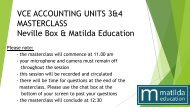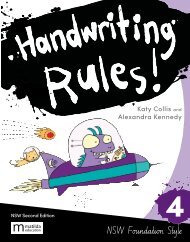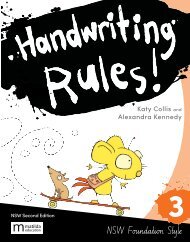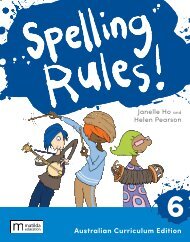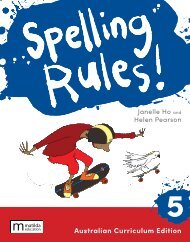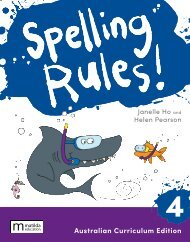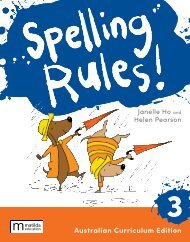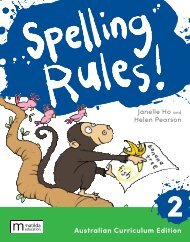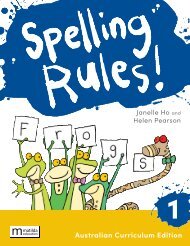Good Science Victorian Curriculum Year 7
Digital sample of Matilda's newest publication, Good Science Victorian Curriculum Year, authored by Emma Craven and Aaron Elias. For more information visit www.matildaeducation.com.au or email Katrina Tucker, katrinatucker@matildaed.com.au
Digital sample of Matilda's newest publication, Good Science Victorian Curriculum Year, authored by Emma Craven and Aaron Elias. For more information visit www.matildaeducation.com.au or email Katrina Tucker, katrinatucker@matildaed.com.au
You also want an ePaper? Increase the reach of your titles
YUMPU automatically turns print PDFs into web optimized ePapers that Google loves.
BIOLOGICAL SCIENCES<br />
2.3<br />
THE LINNAEAN<br />
CLASSIFICATION<br />
SYSTEM<br />
LEARNING INTENTION<br />
At the end of this lesson I will<br />
understand the importance<br />
of the Linnaean classification<br />
system and describe its key<br />
elements.<br />
KEY TERMS<br />
naturalist<br />
someone who studies nature<br />
and its history<br />
species<br />
a single, specific type of living<br />
organism<br />
1<br />
Scientists can classify living organisms in many different ways.<br />
What’s most important is that every scientist uses the same<br />
system, so that their findings can be compared and they can<br />
share information.<br />
A system for grouping living things was first proposed by<br />
Swedish naturalist Carolus (Carl) Linnaeus in 1753. It’s known<br />
as the Linnaean classification system and has been used by<br />
scientists ever since.<br />
Eight Linnaean levels, from domain to species<br />
Carolus Linnaeus’ system classifies organisms by levels called taxa,<br />
and each of these levels is divided into groups. These groups are based<br />
mainly on cell and structural characteristics, and also on how the<br />
organisms behave and reproduce.<br />
At the highest level, these groups are huge – a single group might<br />
contain all plant life in the entire world. As you go down the levels, the<br />
groups become more specific and contain less species.<br />
At the top of the system, the most general classifications are domains<br />
and kingdoms. The characteristics used to separate these groups are<br />
based on cell structure. At the bottom of the system are genuses and<br />
species. This is where you can identify individual types of organisms.<br />
Here is how the brush-tailed rock wallaby is classified:<br />
LITERACY LINK<br />
WRITING<br />
Create a mnemonic to<br />
remember the order of<br />
classification: domain, kingdom,<br />
phylum, class, order, family,<br />
genus, species. An example is<br />
‘Dear Katy Perry Can Often Find<br />
Green Shoes’.<br />
Classification level<br />
Domain<br />
Kingdom<br />
Phylum<br />
Classification for brush-tailed rock wallaby<br />
Eukaryota (living organisms with specialised cells)<br />
Animalia (animals)<br />
Chordata (animals with a backbone)<br />
NUMERACY LINK<br />
GRAPHING<br />
97% of all animal species are<br />
invertebrates. Draw a pie chart<br />
showing the percentages of<br />
invertebrates and vertebrates.<br />
Class<br />
Order<br />
Family<br />
Mammals<br />
Marsupialia (marsupials)<br />
Macropodidae (wallabies, kangaroos, pademelons)<br />
Genus<br />
Petrogale (wallabies)<br />
Species<br />
penicillata (brush-tailed rock wallaby)<br />
How many levels are in the Linnaean classification system?<br />
22 GOOD SCIENCE VICTORIAN CURRICULUM 7










